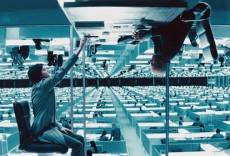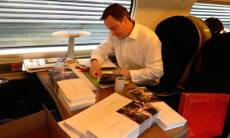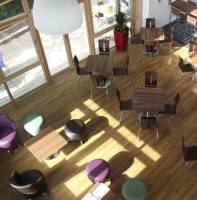November 1, 2013
There is very little about flexible working that is actually flexible
 It’s pretty clear why some of the world’s greatest writers have been drawn to the human propensity for moral and linguistic inversions and subversions. Books like 1984, Catch 22 and A Clockwork Orange are predicated on the idea. And it’s not one limited to literature. If we look, we can see it going on all around us. In the field of workplace design and management we can see it in the use of the word ‘flexible’ as used in the phrase flexible working. This is a word that in this particular context is coming to mean something like its opposite. According to a survey from YouGov, the 9 to 5 is a thing of the past, supplanted by a style of work labelled flexible but which involves a third of us working for over ten hours a day, many at home right up until the point we go to bed with a smartphone that sits by our side, to wake us with a beep and a wodge of new notifications the next morning.
It’s pretty clear why some of the world’s greatest writers have been drawn to the human propensity for moral and linguistic inversions and subversions. Books like 1984, Catch 22 and A Clockwork Orange are predicated on the idea. And it’s not one limited to literature. If we look, we can see it going on all around us. In the field of workplace design and management we can see it in the use of the word ‘flexible’ as used in the phrase flexible working. This is a word that in this particular context is coming to mean something like its opposite. According to a survey from YouGov, the 9 to 5 is a thing of the past, supplanted by a style of work labelled flexible but which involves a third of us working for over ten hours a day, many at home right up until the point we go to bed with a smartphone that sits by our side, to wake us with a beep and a wodge of new notifications the next morning.










 The finest closing sentence of any novel in my opinion is that in The Great Gatsby. “So we beat on, boats against the current, borne back ceaselessly into the past.” It is a reference to the futility of our attempts to escape the past, even as we look to the future, dreaming of how “tomorrow we will run faster, stretch out our arms farther”. F Scott Fitzgerald was referring to people when he wrote it, and Jay Gatsby in particular, but it’s a passage that resonates in a number of ways, especially in those areas of our lives that deal most intimately with what it means to be human. And one of these is self-evidently the workplace, where any articular attempt to define the ideal office for a particular time, including the future, is complicated by the fact that we must always meet the needs of the beasts that inhabit it. Regardless of the tools we have at our disposal with which to work more effectively, or just plain ‘more’ we remain fundamentally the same animals we were thousands of years ago.
The finest closing sentence of any novel in my opinion is that in The Great Gatsby. “So we beat on, boats against the current, borne back ceaselessly into the past.” It is a reference to the futility of our attempts to escape the past, even as we look to the future, dreaming of how “tomorrow we will run faster, stretch out our arms farther”. F Scott Fitzgerald was referring to people when he wrote it, and Jay Gatsby in particular, but it’s a passage that resonates in a number of ways, especially in those areas of our lives that deal most intimately with what it means to be human. And one of these is self-evidently the workplace, where any articular attempt to define the ideal office for a particular time, including the future, is complicated by the fact that we must always meet the needs of the beasts that inhabit it. Regardless of the tools we have at our disposal with which to work more effectively, or just plain ‘more’ we remain fundamentally the same animals we were thousands of years ago.











November 5, 2013
Technology fix. What employers can do when social media becomes an addiction
by Pam Loch • Comment, Legal news, Technology, Workplace
Recent research shows that technology has helped us to become nearly five times more productive than we were in the 1970s. As well as enabling social interaction and personal expression, social media such as LinkedIn and Twitter can be valuable business aids for innovation and collaboration. However, with over half of people under 25 admitting they have to check Facebook at least once a day, it’s clear that for many, social media has become more than a form of virtual engagement. This can create something of an issue in the workplace, leaving employers with the dilemma of balancing the positive aspects of online communications while discouraging time wasting. (more…)